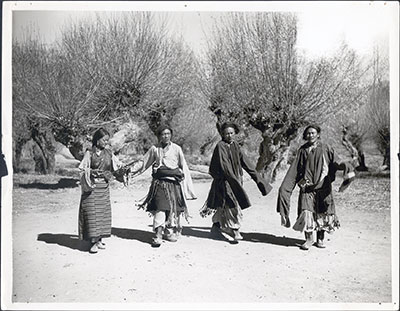
1998.131.257 (Print black & white)


1998.131.257 (Print black & white)

Frederick Spencer Chapman
Frederick Spencer Chapman
November 10th - 12th 1936
Lhasa > Dekyi Lingka
1998.131.257
202 x 260 mm
Dancing , Performing
Print gelatin silver , Enlargement
Donated 1994
Faith Spencer Chapman
British Diplomatic Mission to Lhasa 1936-37
Frederick Spencer Chapman
C.12.11 [view film roll]
SC.T.2.257
Notes on print/mount - The caption 'Kampa Dancers' has been written on the back of the print in pencil [MS 15/2/2005]
Manual Catalogues - Caption in Chapman's hand-written list of negatives made whilst on the Mission to Lhasa, 1936-7 [See PRM Manuscripts Collection]: 4 in line dancing woman (and fiddle) on right [MS 16/03/2006]
Other Information - Description: Chapman gives a description of these performers in his publication Lhasa the Holy City (London: Chatto & Windus, 1938; reprint, London: Readers Union Ltd., 1940, p.272): "Another form of entertainment was provided by troupes of dancers who appeared from time to time at the Dekyi Lingka. One group, known as the Khampa Dancers - since this form originated in the Kham - were skilful acrobats. These were professional players who toured southern Tibet and even went down to Gangtok and Kalimpong. The troupe consisted of a sour-looking but handsome girl who played, alternately, a Tibetan fiddle and a drum or gong similar to those used in the monasteries; and three wild looking men, one of whom clashed small cymbals. The tallest of these was a retired bandit; he was short of his right hand, having it cut off as a punishment. The men wore white balloon shirts tied in at the ankles and, hanging from the belt, a fringe of plaited cords. // Playing their instruments and singing as they danced, the troupe would start stepping backwards and forwards with arms swinging in time to the measure. Gradually they would gather speed until they were whirling round in a circle with outstretched arms and long sleeves flying, so that first one hand and then the other swept the ground" [MS 15/2/2005]
Other Information - Related Images: These same people can also be seen in 1998.131.255 & 1998.131 256 [MS 15/2/2005]
Other Information - Related Images: Images prefixed with 'C.12' comprise a group of negatives containing images of Ladakhi men, Ngagchen Rimpoche, Mir/Amir Khan (the mission cook), football match, Dagg, Kham dancers, Nechung, Drepung, the Potala and the sand track approaching it. They all seem to have been taken between October 28th and November 15th 1936. Chapman has also included this image in a sub-group he titles 'Kampa Dancers and Mummers' in his handlist from the Mission [MS 16/03/2006]
Other Information - Cultural Background: The trouser style is the same as people referred to as Bathang in the south east of Kham region would wear. They would come to Lhasa possibly on pilgrimage and would perform to raise money. The woman is not wearing Khampa or Bathang dress but the ordinary dress of central Tibet. The instrument she is playing is called pi wang. The tassels on the men's dress is used to enhance the dramatic effect of their acrobatic dances; for the same reason the trousers are very baggy to exaggerate the shapes and movement of the dance [TS 31/1/2005]
For Citation use:
The Tibet Album.
"Khampa dancers and musician"
05 Dec. 2006. The Pitt Rivers Museum.
<http://tibet.prm.ox.ac.uk/photo_1998.131.257.html>.
For more information about photographic usage or to order prints, please visit the The Pitt Rivers Museum.
© The Pitt Rivers Museum